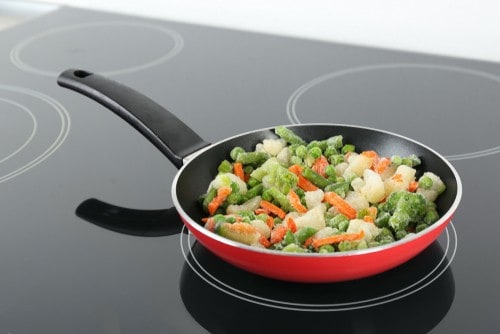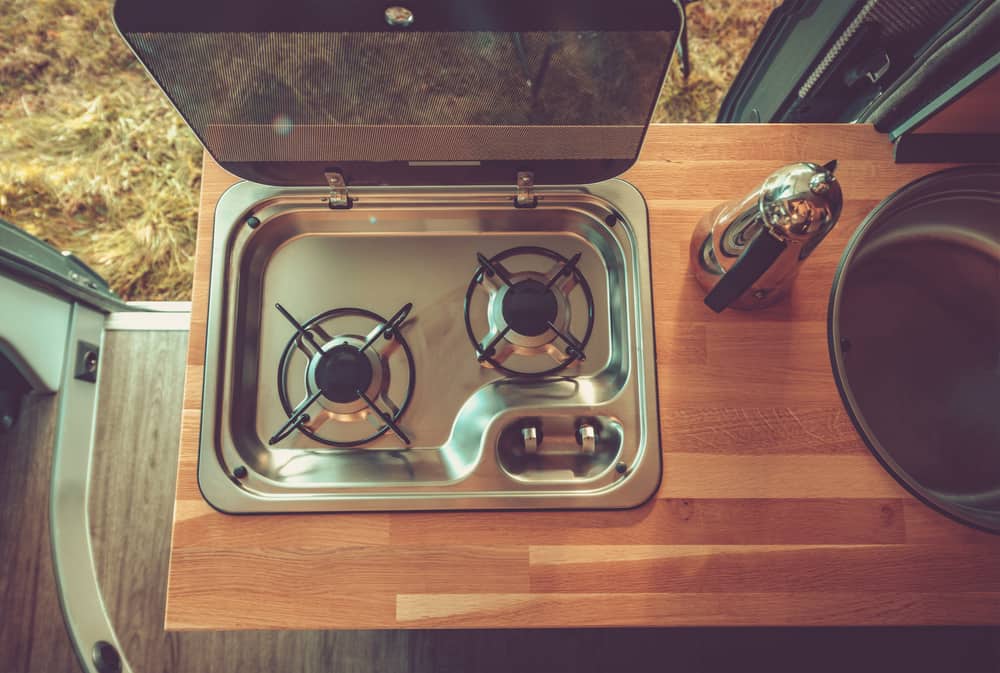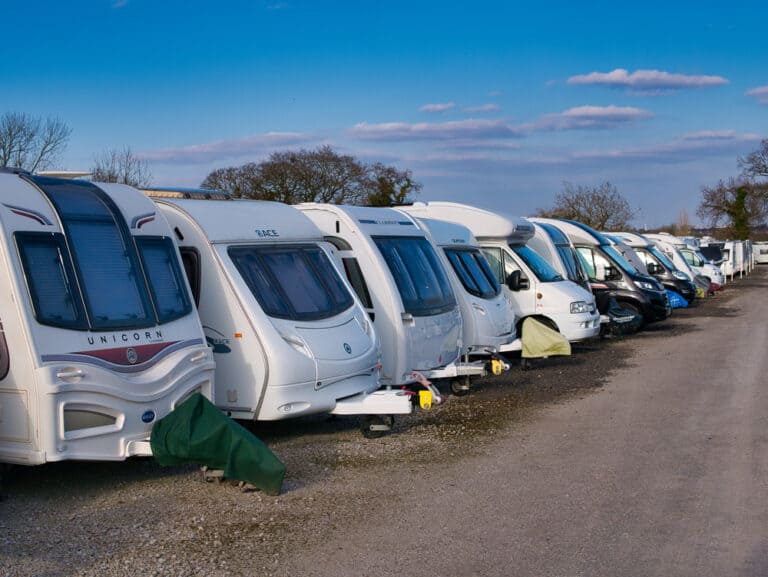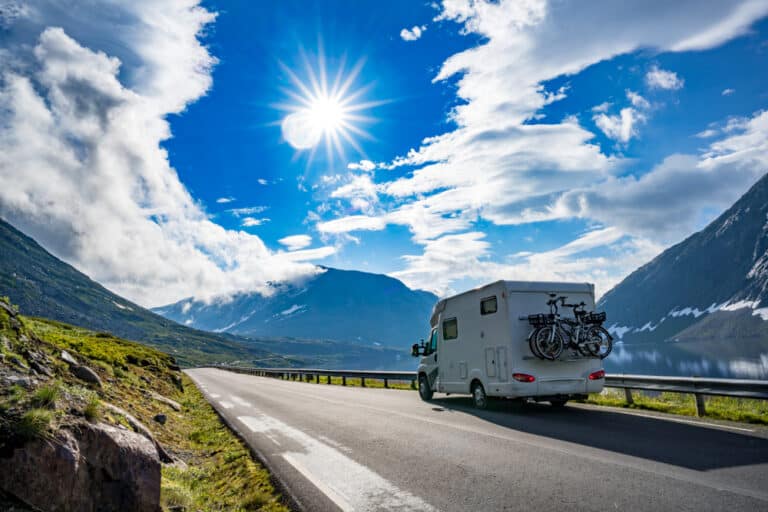Which Type of RV Stove is the Best in 2023
When it comes to cooking in your RV, having a reliable and efficient RV stove is not just a luxury but a necessity. Whether you’re a full-time RVer embarking on exciting adventures or someone who enjoys occasional road trips, the right stove can significantly enhance your experience on the go. The three main types are a gas stove, induction stove, or diesel stove. By examining their pros and cons, we aim to equip you with the knowledge necessary to make an informed decision that suits your unique needs and preferences.
Gas Stoves

Gas stoves have been a trusted companion for RV owners for many years, and their popularity stems from several reasons. One of the key advantages is their affordability and widespread availability. Propane, the fuel typically used for these, can be easily obtained and refilled at most RV parks or gas stations, ensuring that you won’t have to worry about running out of fuel during your culinary adventures on the road.
Pros:
They offer instant heat, allowing you to start cooking as soon as you turn the burner on. This quick and efficient heat distribution is especially useful when you’re pressed for time or simply eager to whip up a delicious meal without delay. Additionally, they provide precise temperature control, enabling you to adjust the flame to suit the requirements of different recipes and cooking techniques. Whether you’re simmering a delicate sauce or searing a steak, they offer the flexibility to achieve the desired results.
Another advantage is their ability to accommodate multiple burners. With multiple burners at your disposal, you can prepare a full-course meal with ease, simultaneously cooking various dishes without the need for extensive juggling and timing. This feature is particularly beneficial for larger families or RVers who enjoy hosting friends and fellow travelers, as it allows for efficient meal preparation and ensures that everyone’s food is served hot and fresh.
Cons:
Despite their numerous benefits, they do come with a few considerations that need to be taken into account. One primary concern is the potential for gas leaks, which can pose a safety hazard. However, it’s important to note that modern ones are equipped with advanced safety features designed to minimize the risks associated with gas leaks. These safety features include automatic shut-off valves that activate if the flame is extinguished, as well as flame sensors that detect abnormal gas flow and shut down the stove if necessary. When properly maintained and used responsibly, they can provide a safe cooking environment for your RV culinary endeavors.
Another aspect to consider when opting for a gas stove is the need to carry propane tanks. While propane is relatively lightweight, the tanks do occupy valuable storage space in your RV. Depending on the size of your RV and the duration of your trips, you may need to plan for sufficient storage capacity to accommodate the propane tanks. Additionally, periodic refills or exchanges of propane tanks are necessary to ensure that you always have an adequate fuel supply. This may require occasional stops at gas stations or RV parks to replenish your propane stock, which should be factored into your travel plans.
The Best Gas Stove for RVs
The Dometic Drop-In Cooktop is a versatile cooking solution that brings convenience and style to your RV. With two burners and a choice between cast iron or flat wire grates, you can tailor your cooking surface to suit your needs. Igniting the burners is a breeze with multiple ignition options, including the Piezo ignition and 12V electronic ignition. The sleek stainless-steel design adds a modern touch to your space, while being part of Dometic’s signature suite ensures seamless compatibility and top-notch performance with other kitchen appliances.
Induction Cooktop

Induction stoves have gained popularity in recent years due to their energy efficiency and fast cooking times. They use electromagnetic fields to directly heat the cookware, rather than heating the entire stove surface. As a result, they are incredibly responsive, heating up and cooling down quickly. They also provide precise temperature control and distribute heat evenly across the cooking surface.
Pros:
One of the major advantages is their unique cooking technology, which ensures that the cooktop itself doesn’t get hot during operation. This greatly reduces the risk of accidental burns or fires, making these a safe option, especially for families with children or pets on board. You can confidently cook your favorite meals without worrying about touching a hot surface or accidental contact causing injuries.
Another benefit is their ease of cleaning. Since the cooktop doesn’t heat up, spills and splatters don’t burn onto the surface. This means that you can simply wipe away any mess with a damp cloth or sponge, without the need for heavy scrubbing or harsh cleaning agents. This convenience not only saves you time but also helps to maintain a clean and tidy cooking area in your RV.
However, it’s essential to note that they require compatible cookware made of ferromagnetic materials, such as cast iron or stainless steel. This is because the stovetop relies on electromagnetic fields to generate heat, which is then transferred to the cookware. Non-magnetic cookware, such as aluminum or glass, will not work. While this may require some adjustments to your existing cookware collection, it’s worth considering the benefits of induction cooking and investing in compatible pots and pans for an optimal cooking experience.
Cons:
One potential drawback is their power requirements. Unlike a gas stove that rely on propane or a diesel that uses diesel fuel, an induction stove operates on electricity. This means that you will need a reliable power source, such as a generator or shore power hookup, to operate them effectively. This can be a limitation if you plan to camp in remote areas without access to electricity, as you will need to rely on alternative power solutions or consider other stove options.
Additionally, it’s important to consider the initial cost. Compared to a gas stove, they tend to have a higher upfront cost. However, it’s important to weigh this against the long-term benefits, such as energy efficiency and safety features. They are known for their energy efficiency, as they directly heat the cookware, resulting in minimal heat loss and faster cooking times. Over time, this can lead to energy savings and potentially offset the initial higher cost of the stove.
The Best Induction Cooktop
The Double Induction Cooktop is the ultimate solution for versatile and precise cooking. With its intuitive digital controls, you can make adjustments on-the-fly without starting over. Choose from 96 pre-programmed temperature settings or fine-tune your own from 100°F to 575°F in 5°F increments, ensuring optimal results every time.
The dual cooking surfaces allow you to cook complete meals simultaneously, and with independent controls, you can adjust settings on each side. The shatter-proof ceramic glass surface guarantees safety, while the fast and efficient induction technology transfers up to 90% of its energy into heat. With automatic shut-off, no hot coils, and no open flames, safety is paramount. The slim design and patented insulation technology ensure even heating for an exceptional cooking experience.
The Best Portable Induction Cooktop
This portable induction cooktop is equipped with dual heating zones and an LCD display screen, you can easily set and control each zone independently. With a child safety lock system, touch control panel, and effortless cleaning, this cooktop ensures safety, ease of use, and convenience. Choose between power mode or temperature mode with 20 preset levels for various cooking tasks. Experience energy efficiency as the cookware directly receives electromagnetic energy, resulting in faster heating and reduced waste. The Power Sharing Feature enhances efficiency by allowing burners to share power in Power Mode, while compatibility with a wide range of cookware adds versatility. Lightweight and attractive, this induction cooktop is perfect for portable uses.
Diesel Stoves

Diesel stoves, while less commonly seen in RVs, are a viable option for those seeking an alternative to gas or inductions. They utilize diesel fuel, which is readily available at most gas stations, making it convenient for RVers to access their fuel source. Diesels offer excellent heat output, capable of quickly bringing a pot of water to a boil or efficiently cooking your favorite meals. They are particularly favored by RVers who already own a diesel-powered motorhome, as it allows them to utilize a single fuel source for both their vehicle and cooking needs.
Pros:
One of the notable advantages is their fuel efficiency. Diesel fuel generally offers better efficiency compared to propane, allowing RVers to cook for longer periods without the need for frequent refueling. This is particularly beneficial for extended camping trips or when cooking multiple meals throughout the day. With a diesel stove, you can enjoy your cooking adventures without worrying about running out of fuel too soon.
However, it’s important to consider that they may produce more soot compared to other stove options. This is a natural byproduct of the combustion process when burning diesel fuel. While it may not be a major concern for many RVers, it’s worth noting that regular cleaning and maintenance of the stove may be necessary to keep it in optimal working condition and maintain a clean cooking environment.
Cons:
One of the potential drawbacks is their limited availability and higher cost compared to gas or inductions. Diesel stoves are less commonly found in the RV market, which means they may be more challenging to source and purchase. Additionally, due to their complexity and specialized nature, professional installation may be required, adding to the overall expense of acquiring a diesel stove. However, for RVers who prioritize the benefits of diesel fuel or already own a diesel-powered motorhome, the investment may be worthwhile for a cohesive and streamlined fuel system.
Another aspect to consider is the noise level. They can be noisier compared to gas or inductions due to the combustion process and the sound of the fuel being burned. While the noise level may vary depending on the specific model and installation, this may be a consideration for RVers seeking a quieter cooking experience or those who prefer a more peaceful environment while preparing meals.
Conclusion

Ultimately, finding the right RV stove will greatly enhance your culinary adventures on the road, ensuring that you can cook delicious meals wherever your travels take you. Since this articles focus was on the stove component only, and not on the RV range with stove/oven combos or cooktops ranges, stay tuned for a separate article going in depth over those.
By evaluating your specific needs, weighing the pros and cons of each RV stove type, and considering the practical aspects of fuel availability and power requirements, you can make an informed decision that will meet your cooking needs and preferences. Whether you opt for a gas stove, induction stove, or diesel stove, you’ll be well-equipped to enjoy the pleasures of cooking while embracing the nomadic RV lifestyle.
PLEASE NOTE: I participate in the Amazon affiliate program, which provides a means for me to earn a small commission by linking to products there. My opinions are my own and I only link to products I can recommend to friends and family with total confidence. Using these links won’t cost you an extra dime!
Looking for some more helpful product guides? Check out my other blog posts.







